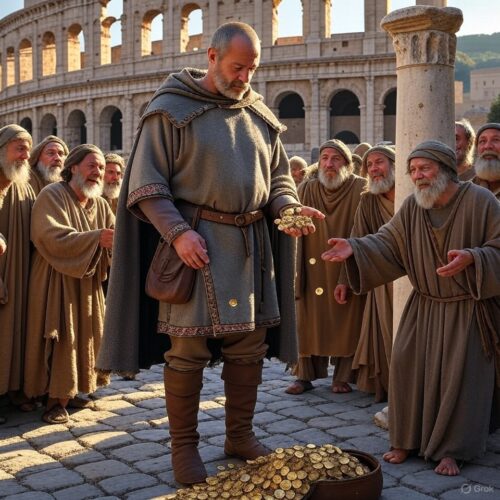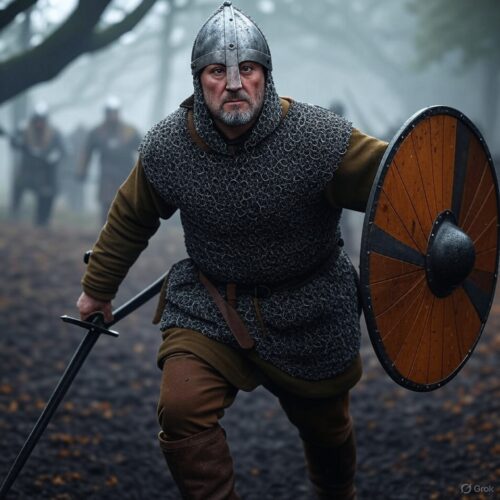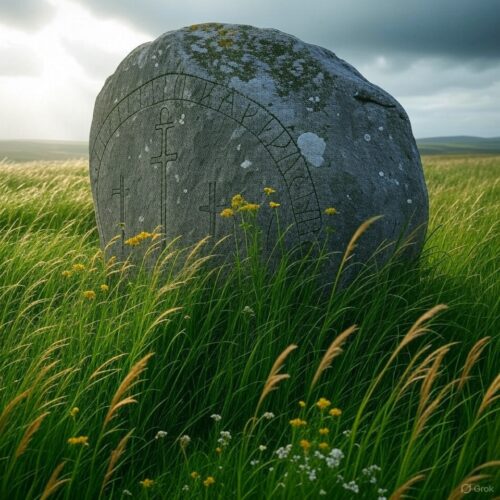Welcome to a deep dive into one of history’s most misunderstood figures—Macbeth, the real King of Scotland. Forget the witches, the dagger visions, and the blood-soaked tragedy penned by Shakespeare. Today, on August 15, we’re peeling back the layers of myth to uncover the authentic story of a warrior-king whose reign ended in a clash of swords and ambitions at the Battle of Lumphanan. This isn’t just a dusty tale from the 11th century; it’s a riveting chronicle of power, loyalty, and survival in medieval Scotland. We’ll explore the historical depths with rich details, from the turbulent kingdom of Alba to the intricate web of alliances and betrayals. And then, we’ll bridge the centuries to show how this ancient drama can ignite your own life with purpose and resilience. Buckle up—this is history at its most thrilling, packed with battles, pilgrimages, and a king who ruled far longer than his fictional counterpart ever dreamed.
### The Roots of a Kingdom: Scotland in the 11th Century
To truly grasp the significance of August 15, 1057, we must journey back to the Scotland of the early Middle Ages, a land known as Alba. This was no unified nation as we know it today but a patchwork of Gaelic-speaking clans, Viking-influenced earldoms, and semi-independent regions ruled by powerful mormaers—essentially earls or high stewards who wielded immense local authority. The kingdom had emerged from the unification efforts of earlier kings like Kenneth MacAlpin in the 9th century, who blended Pictish and Scottish traditions to forge Alba. By the 11th century, the throne was a prize contested through bloodlines, battles, and strategic marriages, often complicated by external threats from England, Norway, and even the distant Byzantine Empire’s echoes through Viking connections.
Alba’s society was deeply rooted in kinship and fosterage systems, where children were raised by allied families to build unbreakable bonds. Warfare was commonplace, not the grand sieges of later eras but brutal skirmishes over fertile lands like Moray in the north or Strathclyde in the south. Religion played a pivotal role too; Christianity had taken hold, with monasteries like Iona serving as spiritual and political hubs. Kings were expected to be warriors, judges, and patrons of the church, balancing the sword with the cross. It was in this volatile world that Macbethad mac Findláech—Macbeth, son of Findláech—rose to prominence.
Born around 1005, Macbeth hailed from the powerful Cenél Loairn kindred, a branch of the Dál Riata Scots. His father, Findláech, was Mormaer of Moray, a region rich in resources and strategically vital for controlling northern Scotland. Findláech’s murder in 1020 by his nephews left a power vacuum, setting the stage for Macbeth’s ascent. By 1032, Macbeth had become Mormaer of Moray himself, possibly after orchestrating or benefiting from the death of the previous holder, Gille Coemgáin, who was burned alive in his hall along with 50 followers—a grim but not uncommon fate in those times. This event, shrouded in mystery, highlights the ruthless politics of the era, where revenge and ambition intertwined.
Macbeth’s marriage to Gruoch, Gille Coemgáin’s widow, was a masterstroke. Gruoch, likely a granddaughter of King Kenneth III, brought royal blood and legitimacy. She already had a son, Lulach, from her first marriage, whom Macbeth adopted as his heir since the couple had no children together. This union solidified Macbeth’s claim, blending Moray’s might with potential throne rights. In 1031, Macbeth submitted to Cnut the Great, the Danish king who ruled England and parts of Scandinavia, alongside King Malcolm II—his possible grandfather—and another ruler. This act of homage reflected the interconnected North Sea world, where Scottish kings navigated Viking overlords and English pressures.
### The Path to the Throne: From Mormaer to King
The turning point came in 1040. King Duncan I, grandson of Malcolm II, ascended the throne in 1034 after Malcolm’s death. Duncan, young and ambitious, sought to consolidate power by invading Moray, perhaps to subdue the independent-minded mormaers. The clash occurred at Bothnagowan (Pitgaveny) near Elgin on August 14, 1040. Far from Shakespeare’s stealthy assassination in a castle bedchamber, this was a full-scale battle where Duncan’s forces were routed, and the king himself slain by Macbeth’s troops. Macbeth, then in his mid-30s, seized the crown with minimal opposition, a testament to his support among the nobility.
Why was there no immediate backlash? Duncan’s reign had been marred by failures, including a disastrous campaign against Northumbria in 1039-1040, where he lost heavily. Macbeth, by contrast, represented stability and strength from the north. His coronation at Scone, the ancient site with the Stone of Destiny, marked the beginning of a 17-year rule—remarkably long for the period, outlasting many contemporaries plagued by short, violent tenures.
### A Reign of Prosperity and Pilgrimage
Macbeth’s kingship was far from the tyrannical nightmare of Shakespeare’s play. Contemporary chronicles, like the Annals of Tigernach, call him “renowned” and note his generosity. He maintained peace internally, fostering alliances through fosterage and marriage. Externally, he dealt with Viking threats; the Orkneyinga Saga recounts conflicts with Thorfinn Sigurdsson, Earl of Orkney, over Caithness. In one episode, Thorfinn defeated a Scottish force led by “Karl Hundason,” possibly a pseudonym for Macbeth, in a sea battle involving fire ships and hand-to-hand combat. These sagas paint vivid pictures: warriors clad in mail coats, wielding broadswords and axes, clashing amid the roar of waves and cries of ravens.
One of the most fascinating aspects of Macbeth’s reign was his 1050 pilgrimage to Rome. At a time when travel was perilous—crossing bandit-infested lands, stormy seas, and Alpine passes—this journey underscored his piety and wealth. The Chronicle of Melrose records that he “scattered money like seed to the poor” in Rome, a gesture that enhanced his reputation as a Christian king. Imagine the scene: a Scottish monarch, accompanied by retainers, arriving in the Eternal City amid the ruins of emperors, offering alms at St. Peter’s Basilica. This act not only fulfilled religious duties but also forged diplomatic ties, perhaps seeking papal support against English incursions.
Domestically, Macbeth reformed laws and supported the church, endowing monasteries and promoting Gaelic culture. His court at places like Dunsinane Hillfort—a real Iron Age site later romanticized—buzzed with bards reciting epic poems, harpers playing tunes, and feasts of venison and ale. Life for ordinary Scots involved farming barley and oats, herding cattle, and weaving wool, but under Macbeth, raids decreased, allowing trade to flourish with Ireland and the Continent.
Yet, shadows loomed. Duncan’s sons, Malcolm and Donald Bán, fled—Malcolm to England, where he was sheltered by Earl Siward of Northumbria, his maternal uncle. This exile sowed seeds of revenge.
### The Gathering Storm: Invasion and Defeat at Dunsinane
By 1054, tensions erupted. Edward the Confessor, King of England, ordered Siward to invade Scotland, ostensibly to restore Malcolm—now called Máel Coluim—to his inheritance in Strathclyde or Cumbria. The Anglo-Saxon Chronicle describes a massive battle on July 27, 1054, at Dunsinane, with heavy losses: Siward lost his son Osbeorn and nephew, while Macbeth’s side suffered thousands dead. Though Macbeth retained the throne, the invasion weakened him, restoring Malcolm to southern lands and exposing fractures in his rule.
The battle itself was chaotic: English housecarls in chainmail charging uphill against Scottish spearmen and Highland warriors. Arrows flew, swords clashed, and the ground ran red. Shakespeare borrowed the name “Dunsinane” but twisted the outcome— in reality, Macbeth survived and ruled three more years.
Post-Dunsinane, Macbeth faced rebellions. He retreated north, consolidating in Moray, but Malcolm pressed on, supported by English arms and perhaps disaffected Scottish nobles weary of prolonged conflict.
### The Fatal Clash: Battle of Lumphanan, August 15, 1057
The climax arrived on August 15, 1057, at Lumphanan in Aberdeenshire. After crossing the Cairnamounth Pass—a rugged mountain route—Macbeth confronted Malcolm’s forces in a wooded area. The battle was no grand spectacle but a skirmish, perhaps an ambush. Tradition places it at Camas an Fhais or Camas an Fheis, with Macbeth’s Stone—a massive boulder—marking where he was mortally wounded.
Details are sparse, drawn from chronicles like the Prophecy of Berchán, which poetically describes Macbeth’s wounding and death days later at Scone. Malcolm, wielding a sword or spear, struck the fatal blow, avenging his father after 17 years. Macbeth, aged about 52, fell not as a tyrant but as a king defending his realm. His body was interred on Iona, the sacred isle of kings, alongside ancestors like Kenneth MacAlpin.
The aftermath was swift. Lulach, Macbeth’s stepson, was crowned at Scone in September 1057 but reigned mere months before Malcolm assassinated him at Essie in 1058, claiming the throne as Malcolm III. Malcolm’s reign shifted Scotland toward Anglo-Norman influences, especially through his wife Margaret, paving the way for the House of Dunkeld.
### Myth vs. Reality: Shakespeare’s Shadow
Shakespeare’s 1606 play, inspired by Raphael Holinshed’s Chronicles, transformed Macbeth into a cautionary tale of ambition. The Bard, writing for King James I—a descendant of Malcolm and Banquo—amplified propaganda against Macbeth, portraying him as a regicide manipulated by witches and a scheming wife. Historically, no witches prophesied; Gruoch wasn’t a murderous Lady Macbeth but a pious queen who endowed churches. Duncan’s death was battlefield honor, not betrayal, and Macbeth’s rule was stable, not despotic.
This distortion arose from biased sources: English chroniclers favored Malcolm’s line, while Gaelic accounts were suppressed. Yet, the play’s enduring appeal lies in its human drama—ambition’s perils, guilt’s torment—echoing real historical themes without the facts.
### Echoes Through Time: Macbeth’s Legacy in Scottish History
Macbeth’s fall marked a pivot. Malcolm III’s victory integrated Scotland more with England, leading to feudal reforms and eventual wars of independence. Moray’s independence waned, and Viking influences faded. Culturally, Macbeth became a symbol: in Gaelic folklore, he’s a heroic figure; in English narratives, a villain. Sites like Lumphanan Peel Ring, a 13th-century castle built over the battlefield, and Macbeth’s Stone draw visitors, blending history with legend.
Archaeology adds layers: excavations at Dunsinane reveal fortifications, while Iona’s graves whisper of buried kings. The real Macbeth reminds us that history is written by victors—Malcolm’s descendants shaped the tale, but modern scholars reclaim his nuanced legacy.
### Broader Context: The North Sea World and Viking Shadows
To appreciate August 15, 1057, consider the wider canvas. Scotland was part of a Viking-dominated North Sea empire. Thorfinn the Mighty, Earl of Orkney, controlled vast territories, and his saga clashes with Macbeth highlight naval warfare: longships with dragon prows, archers firing from decks. Cnut’s 1031 submission showed Scotland’s vulnerability to Danish power, which waned after Cnut’s death in 1035.
Internally, the tanistry system—where heirs were elected from royal kin—fueled conflicts. Macbeth’s claim via marriage and battle fit this, unlike Duncan’s attempt to impose primogeniture by naming Malcolm prince of Cumberland.
Church influence grew; Macbeth’s Rome pilgrimage aligned with reforms under Pope Leo IX, who combated simony. Returning, Macbeth likely brought relics or ideas, enriching Scottish monasticism.
### Daily Life Under Macbeth: A Glimpse into Medieval Scotland
Envision a day in 1050s Alba: peasants in thatched huts rising at dawn to till fields with ard plows, women spinning wool by peat fires. Nobles hunted deer in forests, feasting on oatcakes and salmon. Bards sang of heroes like Finn mac Cumhaill, while monks copied manuscripts in Latin and Gaelic.
Macbeth’s court moved between strongholds: Forres, Inverness, Dunsinane. Justice was dispensed at assemblies, with fines for crimes like theft—cattle rustling a capital offense. Trade included wool to Flanders, slaves (sadly) to Ireland, and amber from the Baltic.
Warfare tech: spears, round shields, occasional bows. No plate armor—leather and mail for elites. Battles were personal, decided by morale as much as numbers.
### The Women of Macbeth’s World: Gruoch and Beyond
Gruoch, often overlooked, was a force. As queen, she co-signed charters, a rarity, showing her influence. Her lineage from Kenneth III made her a king-maker. After Macbeth’s death, she vanishes from records, perhaps retiring to a nunnery.
Other women: Malcolm’s mother, Sybil, linked to Siward, brought English ties. Margaret, Malcolm’s later wife, sainted for reforms, contrasted Gruoch’s Gaelic roots.
### Aftermath and Long-Term Impacts
Malcolm III’s reign (1058-1093) anglicized Scotland: introducing knights, castles, and French names. He invaded England multiple times, dying in battle. His descendants, like David I, feudalized the realm, diminishing mormaers’ power.
Macbeth’s line ended with Lulach’s death, but Moray kin rebelled later, like in 1130. The name “Macbeth” faded, associated with tragedy.
In literature, besides Shakespeare, Walter Scott and others romanticized him. Modern works, like Dorothy Dunnett’s novels, portray the real king sympathetically.
### Fun Historical Tidbits: What Ifs and Curiosities
What if Macbeth won at Lumphanan? Scotland might have stayed more Gaelic, delaying Norman influences. Fun fact: The “Macbeth” curse in theater stems from the play’s dark themes—actors say “The Scottish Play” to avoid bad luck.
Another gem: Lumphanan’s name derives from Gaelic “Lann Finnan,” church of St. Finan, tying to religious sites.
### Lessons from Lumphanan: Applying Macbeth’s Story to Your Life Today
While the historical saga dominates our tale, the outcome of August 15, 1057—Macbeth’s fall after a long, stable reign—offers profound benefits for modern individuals. It teaches that true leadership stems from legitimacy and peace, not just conquest; that resilience in adversity builds character; and that ethical ambition endures. By applying these, you can transform challenges into growth, much like Macbeth’s pilgrimage turned potential weakness into strength.
Here are specific ways this historical fact benefits you today:
– **Cultivate Lasting Alliances:** Macbeth’s marriage and adoptions show relationships matter. In your life, build networks through mentorship or collaborations, leading to career advancements or personal support.
– **Embrace Ethical Ambition:** Unlike the play’s villain, real Macbeth seized power legitimately in battle. Apply this by pursuing goals honorably—e.g., upskilling for promotions without undercutting colleagues.
– **Prioritize Inner Peace Amid Turmoil:** His Rome pilgrimage amid threats highlights self-care. Today, take “pilgrimages” like retreats to recharge, boosting mental health and productivity.
– **Learn from Setbacks:** Surviving Dunsinane for three years demonstrates resilience. When facing job loss or failure, regroup and strategize, turning defeats into comebacks.
– **Honor Your Legacy:** Buried on Iona, Macbeth’s memory endured. Craft your legacy through journaling achievements or mentoring others, ensuring positive impact.
A Step-by-Step Plan to Apply This:
- **Research Your Roots (Week 1):** Study your family history or a personal “battle” from your past. Reflect on lessons, journaling 15 minutes daily.
- **Build Alliances (Weeks 2-3):** Reach out to 3 contacts for coffee chats or collaborations. Practice active listening to strengthen bonds.
- **Pursue a “Pilgrimage” (Week 4):** Plan a solo trip or workshop for self-reflection. Use it to set ethical goals, like a career shift.
- **Overcome a Setback (Ongoing):** Identify a current challenge. Break it into steps—e.g., if job-hunting, update resume, network weekly, track progress.
- **Craft Legacy Actions (Month 2+):** Mentor someone or volunteer. Review quarterly how your actions echo Macbeth’s stability.
By weaving these into your routine, you’ll harness history’s motivational power, turning ancient facts into modern triumphs. Macbeth’s story isn’t just past—it’s your blueprint for a bolder life.

